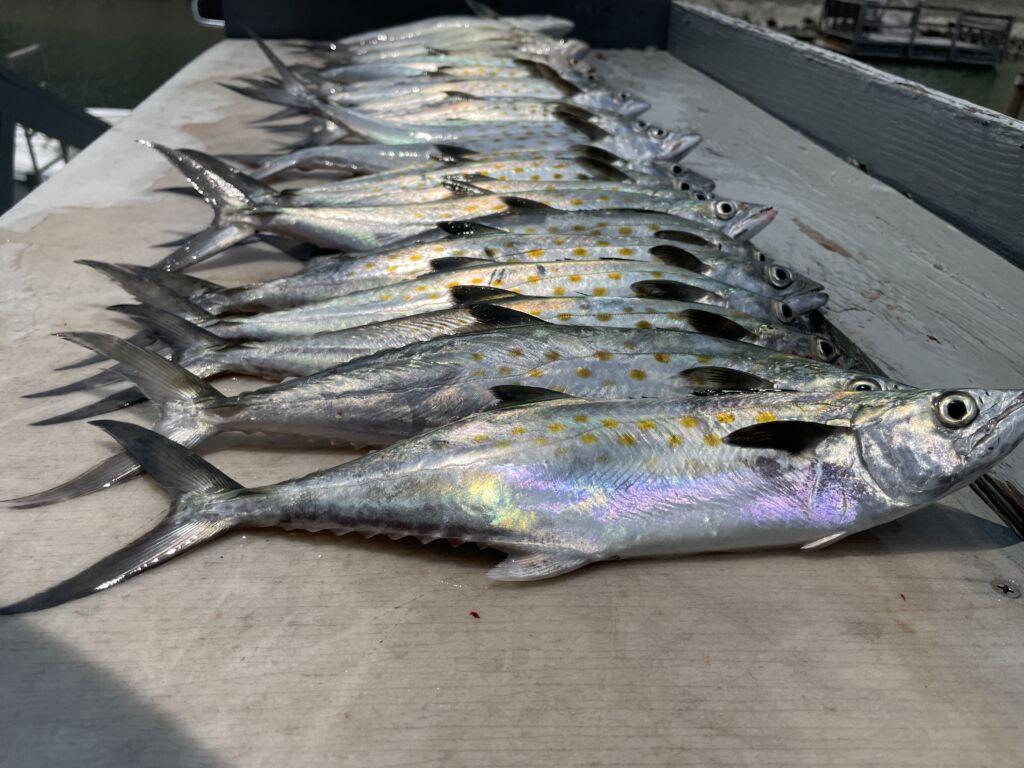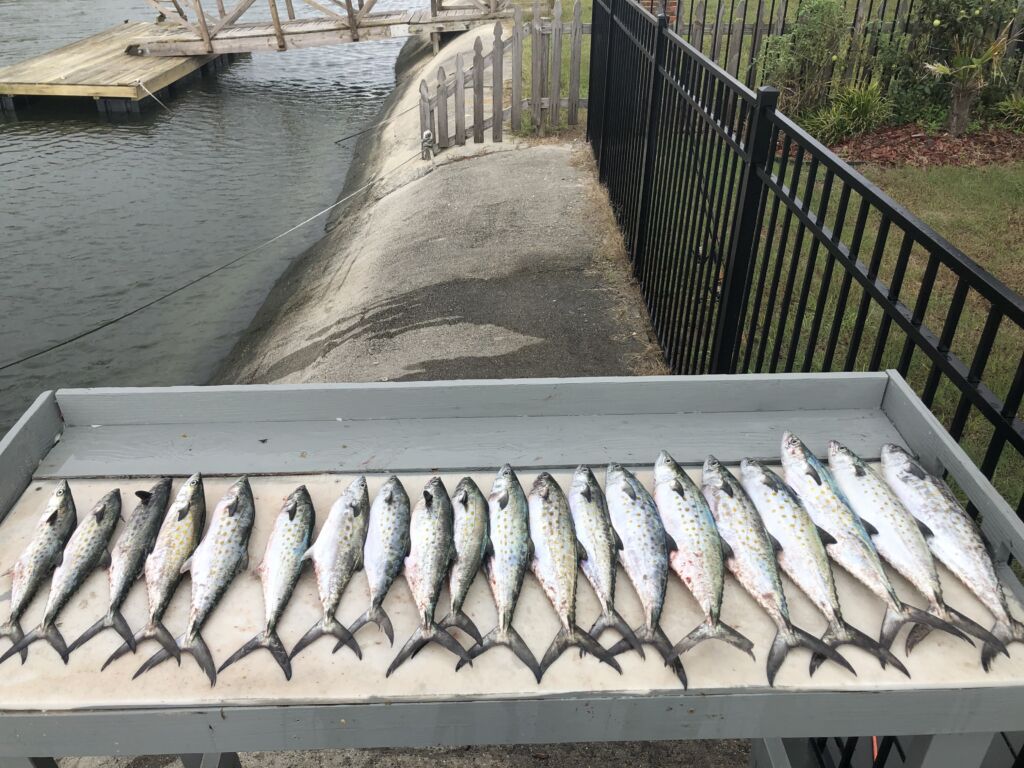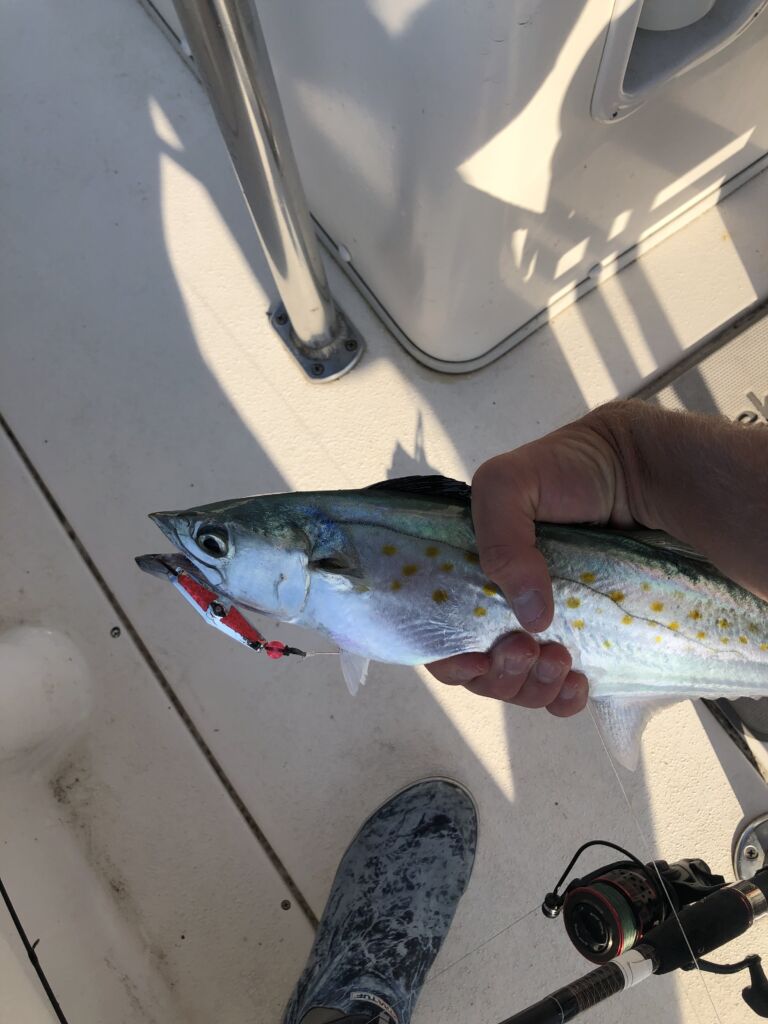Spanish Mackerel are one of the most prevalent species across the entire East Coast and even into the Gulf of Mexico. Due to their huge numbers, schooling nature, voracious eating patterns, and excellent table fair, Spanish Mackerel are a very sought-after species for all levels of anglers. From personal experience, I can assure you that there is nothing more exciting than going out early in the morning when the water is glass-slick and running your boat up on a school of busting Spanish and throwing artificials. When the Spanish are biting you can have a good day—a very good day. We’ve even had days where we’ve caught over 100 Spanish Mackerel in under 4 hours. But that’s enough bragging for now, it’s time to give y’all some tips and tactics on how you can have days like this for yourselves.
Proven Baits for Spanish Mackerel: Natural vs. Artificial Strategies
The baits for Spanish Mackerel, much like any other type of fish, can be broken down into natural and artificial baits. Now everyone is going to tell you a different strategy and personal preference as to how you should fish for Spanish, but I’m going to compile the most widespread and well-known methods that have been proven to succeed in the past. To make this even easier, I’m breaking down the baits into natural and artificial.
Natural: When fishing with natural baits for Spanish Mackerel, you want to stay away from dead baits. Not to say that it is completely impossible, but more often than not, they won’t hit dead bait. Spanish are high-speed predators and often don’t want a chunk of mullet or pogy. If you’re going to use natural baits, make sure they are alive. Some of these popular live baits include pogies/menhaden/bunker and finger mullet. Now I realize that only having two kinds of live bait limits your options significantly, but if you can get your hands on a couple dozen of these, you should be in good shape.

Artificial: Fishing with live baits for Spanish Mackerel can certainly be a good option, especially when targeting the larger class of Spanish, but if you just want numbers (and size as well occasionally) artificials are most definitely the way to go. To break this down even further I’m dividing artificials into casting and trolling.
- Trolling: Now when you’re trolling for Spanish Mackerel, there are tons of different artificials you could potentially use, but the one bait that every angler can pretty consistently agree on is the Clarkspoon. While very simple, they are quite lethal. I prefer using gold or silver Clarkspoons (you can also add colored tape which can vary presentation) that are between sizes 00 and 1. Clarkspoon also makes Duster Rigs and Tree Rigs which are also extremely effective.
- Casting: Now this is where the real fun begins. When I tell you this category of baits couldn’t be more different than the trolling lures I mean it. When the Spanish Mackerel are running, you can throw anything you want at them and there’s a pretty good chance you’re gonna get hit. Some of my personal favorites are Gotcha plugs, basic silver and gold casting spoons with a single treble hook (easy to find in Walmart or Bass Pro), bucktails, glass minnow imitation jigs, and more. These fish aren’t being picky, they’re often caught up in a frenzy and if you can get something shiny in front of one, they’re gonna smoke it.
Hopefully, with this brief discussion of bait, you can see the importance of being familiar with all different types. Lucky for you, the Fishbox App provides anglers with the knowledge they need to narrow down their decisions even more based on around 50 metrics related to the bite. Don’t make your bait choice out of random chance, instead download the fishing forecast app today and be more efficient in how you target Spanish Mackerel.
Essential Tactics for Catching Spanish Mackerel: Rigs, Gear, and Spreads
Rigs: There’s not too much variation on the rigs for Spanish Mackerel compared to other species. This being said, three primary rigs should cover all of your bases for fishing for Spanish Mackerel.
- Live bait rigs: The live bait rig for Spanish is extremely simple. Since you’re going to be chumming with live mullet or other live bait a lot of the time, you’re simply going to be drawing the Spanish Mackerel to you, so you end up pretty much free-lining bait. Your rig should just be a 20-30-pound monofilament leader (size down if the fish are being finicky or size up to wire if you’re getting cut off) attached to a relatively small live bait hook. Then all you must do is grab your live finger mullet or pogy and hook it through the mouth or tail and you’re ready to go.
- Trolling rigs: When trolling for Spanish there are only two main ways to rig your tree rigs or Clarkspoons. First, you can use planners. These drop your Clarkspoons further down in the water column and can be extremely productive if used correctly. I always use both a size 1 and 2 planer connected to the main line. The planer is then connected to about 10 feet of 20-30-pound monofilament leader which is tied directly to your Clarkspoon. Second, you can use bullet trolling weights which I normally use anywhere from 1 to 3 ounces. These should be tied directly to your main line and then connected to 10 feet of 20-30-pound leader which is then tied to your Clarkspoon. This setup will allow your spoon to be between 6 inches and 5 feet off the surface.
- Casting rigs: Casting rigs are also very similar to the live bait rigs in a sense. You’ll connect your main line to a 20-30-pound monofilament leader that is about 2-3 feet long and then tied to whatever artificial bait you’re using. Again, a common problem with Spanish Mackerel is their razor-sharp teeth so you may have to size up to wire to prevent that from happening.

Gear: For trolling rods, especially ones using planers, you need some conventional rods with a bit of backbone because the planners will put significant strain on the rod when run at the correct speeds. Any small to medium size conventional reel will do the job and I like that paired with a 6-foot conventional rod. For my surface trolling rods running bullet weights with Clark spoons, I like using a 7-foot medium Ugly Stick GX2 rod with a size 4000 Penn Fierce II equipped with a 30-pound braid. The best part about this setup is the fact that it can also double as a casting rod if need be. Now on to casting and live bait. I prefer a 6-foot rod with a size 3000 to 4000 Penn Fierce II spooled with a 25-to-30-pound braid. Finally, remember to grab a net before leaving the dock as Spanish Mackerel can sometimes be too big to just pull over the rail easily.
Spreads/Depth: Since you don’t need a spread to cast artificials or fish live bait for Spanish Mackerel, the only time you need to utilize the spread is when you’re trolling. My spread is quite simple and very easy to do even with a smaller boat. All you need is to have two conventional rods and two spinning rods configured as I said above. For the first conventional rod, run a size 2 planer with a Clarkspoon. Drop this planer about 75 feet from the boat. For the next conventional rod do the same thing but drop this one 50 feet behind the boat with a size one planer. If possible, try to put these on opposite sides of your boat and with different colored Clarkspoons. For your two spinning rods, run one with a heavier bullet weight and one that is a little lighter. Stagger these also about 75-100 feet behind the boat and use Clarkspoons as well. Running this spread between 5 and 8 miles per hour during the right conditions should almost always yield fish simply because you’ve covered almost all areas of the water column. Now that we have trolling out of the way, there are a couple of quick tips I want to give you about casting and live bait. First, with live bait, you want to set up near a jetty or some form of underwater structure that you know holds the bait. Then, since you came prepared with a ton of extra mullet, start chucking someone out to bring the Spanish to you. After that, all you gotta do is freeline your bait and it shouldn’t take too long to get hooked up if the Spanish Mackerel are there. On the other hand, when you are casting, especially if there are busting Spanish, you want to keep your lures towards the top of the water as the Spanish are usually chasing glass minnows on the top. Even in doing so, vary your retrieve style and retrieve speed to see what the Spanish want. Additionally, if there are fish there and they just aren’t hitting your lure, don’t be afraid to change it up every so often to see if they might want something different. These are just a few tips to get you started.
Locations, Conditions, and Best Times to Catch Spanish Mackerel
Time of year: Peak season for Spanish Mackerel fishing, especially on the East Coast, is in the Fall in October and November. Spring and Summer are also decent, but you definitely won’t find as many fish the same as you will in the Fall. Spring and Summer often have a lot of smaller class fish, but if you can beat the heat of the day and get out early, you’ll have a pretty good shot of catching them. Then in the winter it just gets too cold unless you’re further South on the East Coast or even in the Gulf.
Water depth: Lucky for us, Spanish Mackerel normally stick in the same depths all year long—now this does vary depending on where you are on the coast, but locals will be more than happy to help you find the goldilocks depth. For us in southern North Carolina, the Spanish Mackerel tends to congregate in the 25-to-35-foot range. This also doesn’t change too much during the year except in the Fall when the Spanish push in a little closer to the beach.
Structure: Rock piles, ledges, drop-offs, and reefs are where most of these Spanish Mackerel are going to congregate. They need a place where bait is going to be and will hang around there. If you’re ever driving around in an area that has bait held tight to some structure on the bottom, then be on the lookout because Spanish will be around. Additionally, Spanish will often just follow bait in huge schools, so follow bait schools and look for busting fish and that’s where you can also find them.
Weather: Just like fishing for King Mackerel, Spanish Mackerel fishing is primarily trolling-based, so the weather has a huge influence on the bite. When it’s rough or windy, it makes it very difficult to keep lines straight and lures look normal in the water. After a big storm with rain, you will also likely have a harder time finding fish because of the water clarity. Preferably, you want very little waves with sun and a little wind so the fish can’t see the surface as easily. If you’re live bait fishing for Spanish you can get away with a bit worse of weather because you’re going to be sitting still, but since you’re going to be out in the ocean you still want a relatively calm day.


A Typical Day of Spanish Mackerel Fishing
This section of the article is something new I’ve thought of recently and think it will greatly help anglers get an idea of what a day of Spanish Mackerel fishing could look like for them from my point of view. The goal of this is to describe what my typical day would look like if I were Spanish Mackerel fishing so you can tweak this plan and then use it if you want to. The day starts early, preferably around 6 in the morning. If we see any live bait on the way out of the inlet, we’ll be sure to cast net some. We continue driving out and drive along the beach for a while to see if there are any signs of life on the surface whether that be bait on the top, fish jumping, or even birds diving. If we see any of these signs, we instantly ready at least a few casting rods to prepare for the action. If the Spanish are there and biting, we’ll often stay on the casting grind all day because it’s just more fun than trolling. However, if there are no signs of surface life or we don’t have casting gear with us, we begin to set the trolling gear out. We’ll troll long lines parallel with the beach at various depths to identify where the Spanish are and once we find them, we’ll tend to stay in that area all day. The only other possible thing we would do is live bait fish for Spanish. If we choose to do that, we’ll normally dedicate a whole day to it and not try to do both casting and trolling. First, we start by getting tons of live mullet—both for bait and chum. We then head out to our predetermined spot and then sit in one place with the trolling motor or anchor. Once we’re still and rigged up, we begin the chumming, and the feeding frenzy begins. So, this is what a typical day of Spanish Mackerel fishing could look like.
Read also: King Mackerel Fishing: Tips and Tricks to Catch More and Bigger Kingfish
Conclusion
I hope this article provides you with everything you need to catch Spanish Mackerel in your local waters. If you have never taken a stab at this species, I highly encourage you to give it a try. If you have fished for Spanish before, I hope this article was helpful and will allow you to find further success in the future. If you have any questions or concerns, please comment on the article and I will get back to you ASAP. Tight lines!
Photo Source: All photos in this article were provided by expert Pierce Latta.
Visit his Instagram profile.
Subscribe to his YouTube channel.








